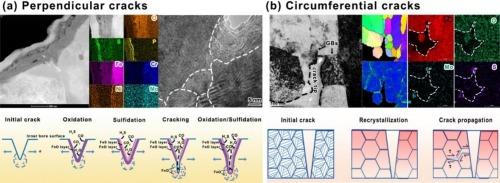Investigating the thermal-chemical-mechanical coupling effects on the cracking behavior of machine gun barrel: Microstructural insights
IF 4.8
2区 材料科学
Q1 MATERIALS SCIENCE, CHARACTERIZATION & TESTING
引用次数: 0
Abstract
The presence of severe cracks at the inner bore of the gun barrel accelerates the erosion failure, whereas the evolution and failure mechanism of crack tips under the thermal-chemical-mechanical coupling effects needs further investigation. Herein, the elemental distribution, phase structure, and strain surrounding the perpendicular and circumferential cracks in a failed gun barrel were investigated in detail by utilizing scanning electron microscopy (SEM), transmission Kikuchi diffraction (TKD), and transmission electron microscopy (TEM). Results indicated that the perpendicular crack was covered by double continuous layers composed of inner FeO oxides and outer Fe0.96S sulfides. Notably, a high-density precipitation of FeO oxides together with severe lattice distortion and localized amorphization was observed at the crack tip, accelerating the growth of the cracks. For the circumferential crack, the presence of fine recrystallized grains alongside coarsened M23C6 carbides was observed at the crack tip. There was a high level of strain concentration along high-angle grain boundaries at the forefront of the circumferential crack tip, resulting in the cracking along grain boundaries. Furthermore, the models for propagation of perpendicular and circumferential cracks under the thermal-chemical-mechanical coupling effects were proposed respectively.

研究热-化学-机械耦合效应对机枪枪管开裂行为的影响:微观结构见解
枪管内孔严重裂纹的存在加速了侵蚀失效,而裂纹尖端在热-化学-机械耦合效应下的演变和失效机理则有待进一步研究。本文利用扫描电子显微镜(SEM)、透射菊池衍射(TKD)和透射电子显微镜(TEM)详细研究了失效炮管中垂直和圆周裂纹周围的元素分布、相结构和应变。结果表明,垂直裂纹被由内层 FeO 氧化物和外层 Fe0.96S 硫化物组成的双连续层所覆盖。值得注意的是,在裂纹尖端观察到了高密度的氧化铁沉淀以及严重的晶格畸变和局部非晶化,这加速了裂纹的生长。对于圆周裂纹,在裂纹尖端观察到细小的再结晶晶粒和粗化的 M23C6 碳化物。在圆周裂纹尖端前沿的高角度晶界处存在高度应变集中,导致沿晶界开裂。此外,还分别提出了热-化学-机械耦合效应下垂直裂纹和圆周裂纹的扩展模型。
本文章由计算机程序翻译,如有差异,请以英文原文为准。
求助全文
约1分钟内获得全文
求助全文
来源期刊

Materials Characterization
工程技术-材料科学:表征与测试
CiteScore
7.60
自引率
8.50%
发文量
746
审稿时长
36 days
期刊介绍:
Materials Characterization features original articles and state-of-the-art reviews on theoretical and practical aspects of the structure and behaviour of materials.
The Journal focuses on all characterization techniques, including all forms of microscopy (light, electron, acoustic, etc.,) and analysis (especially microanalysis and surface analytical techniques). Developments in both this wide range of techniques and their application to the quantification of the microstructure of materials are essential facets of the Journal.
The Journal provides the Materials Scientist/Engineer with up-to-date information on many types of materials with an underlying theme of explaining the behavior of materials using novel approaches. Materials covered by the journal include:
Metals & Alloys
Ceramics
Nanomaterials
Biomedical materials
Optical materials
Composites
Natural Materials.
 求助内容:
求助内容: 应助结果提醒方式:
应助结果提醒方式:


